It’s been a crazy month hasn’t it? We have new cards from Nvidia, new CPUs from Intel, and AMD has already announced a new card as well. What a perfect time to start looking at building a new PC or upgrading your current one. Just in time for upcoming games like Quake even! The GTX 1080 might have hit the market a few weeks ago, but they are still hard to get. Today I’m going to finally sit down and dive into what the 1080 is all about. Then I’m going to run it through all of our tests (and maybe a few new tests as well) and find out if it’s worth throwing down $699 to get Nvidia’s latest and greatest.
Product Name: Nvidia GTX 1080 Founders Edition
Review Sample Provided by: Nvidia
Written by: Wes
Pictures by: Wes
Amazon Link: HERE
Pascal
So to jump right into things, if you don’t know what Pascal is, it is the architecture that the new GTX 1080 and GTX 1070 are based on. This replaces the Maxwell based cards like the GTX 980, 980 Ti, Titan X that has been at the top of Nvidia’s consumer product lineup. Pascal has actually been in the works for a very long time, Nvidia was even talking about it prior to the launch of Maxwell. Last month they blew the lid off of everything with the introduction of the GTX 1080 and the GTX 1070. Jen-Hsun Huang, Nvidia’s CEO, shocked the crowd by announcing that the new GTX 1080 was faster than the powerful and expensive Titan X then while channeling Steve Jobs he followed that up with the announcement that the GTX 1070 would also be faster as well.
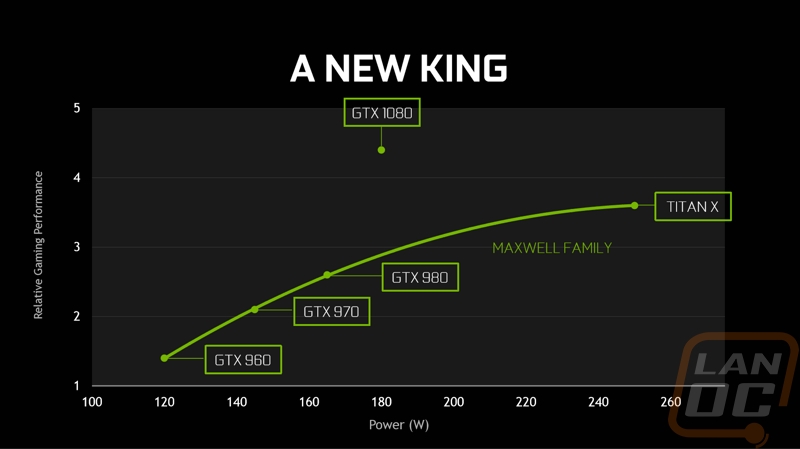
That begs the question, what exactly is changing with Pascal. Well, I can’t cover every single thing here but there were a few big changes that can account for the performance improvement. The first one was a change in how they handle GPU Boost. The old 2.0 version of GPU Boost was very linear as you can see below. The new GPU Boost however makes more adjustments to help keep the card closer to the theoretical maximum overclock. This basically picks up the extra clock speed they were leaving on the table before.
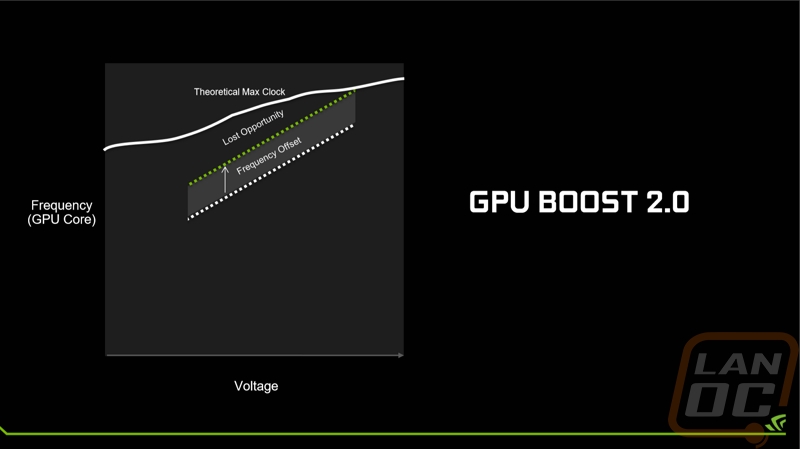
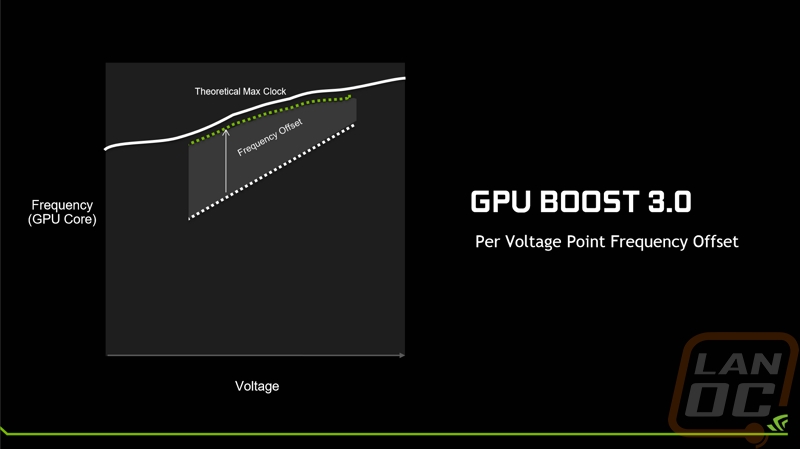
They also moved from a 28nm build process to a new 16nm build process. This means smaller components, shorter distances between things, and less power usage. There was a BIG focus on improving VR performance specifically. Nvidia showed off a breakdown comparing the GTX 980 to the GTX 1080 and how much of the improvements where architecture and process’s in normal gaming as well as VR. The VR performance was helped a lot with a technology that they call Simultaneous MultiProjection. SMP allows Pascal to project to up to 16 viewports, each with the ability to rotate to match the display. Basically, they can render VR much better because the architecture is designed to handle the multiple viewpoints that VR uses. A cool side effect of this new tech is what they call Perspective Surround where they can now better render multi-monitor gaming setups now. Before they would render on a flat plain, now they render to compensate for the angle of your monitors to make it more fluid.
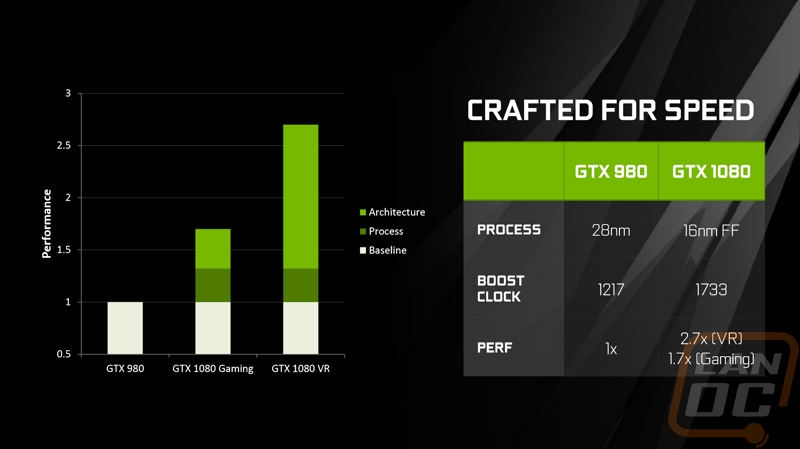
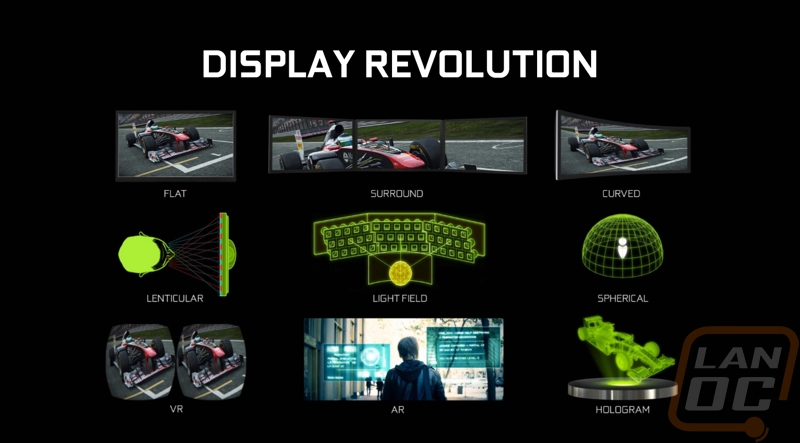
Beyond that, a big portion of the improvements stems around the memory. They moved from GDDR5 to GDDR5X for a faster Data Rate. The GTX 1080’s 256-bit interface, for example, runs at a total data rate of 10 Gbps. In combination with this, they also made drastic changes to memory compression. The bright purple/pink photos below show how much of a frame was compressed before on Maxwell compared to Pascal. It’s still not everything, but that additional compression along with the additional bandwidth makes a big difference. In the slides that Nvidia showed off, they said the total effective bandwidth when combining the two is like 1.7x better than the GTX 980 and the 980 wasn’t exactly a slouch.
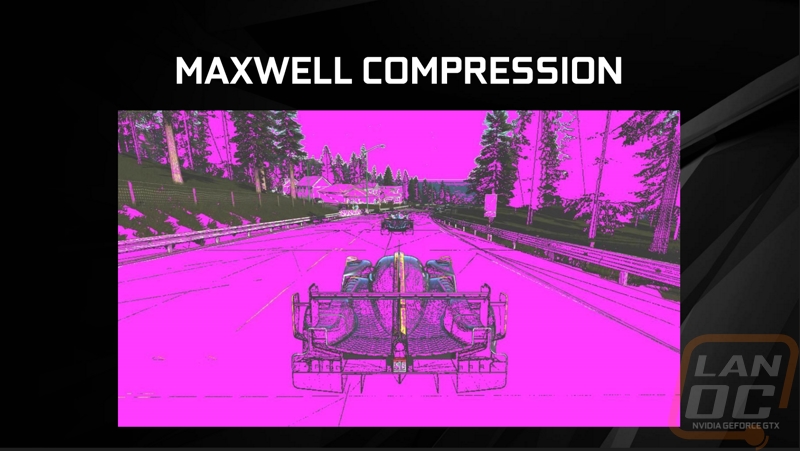
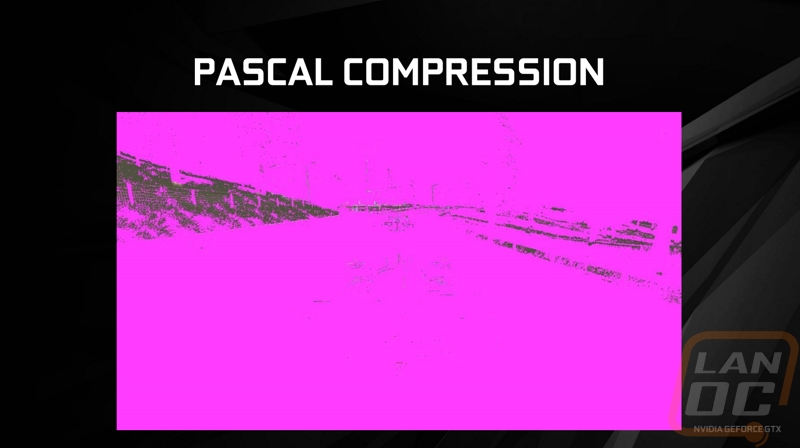
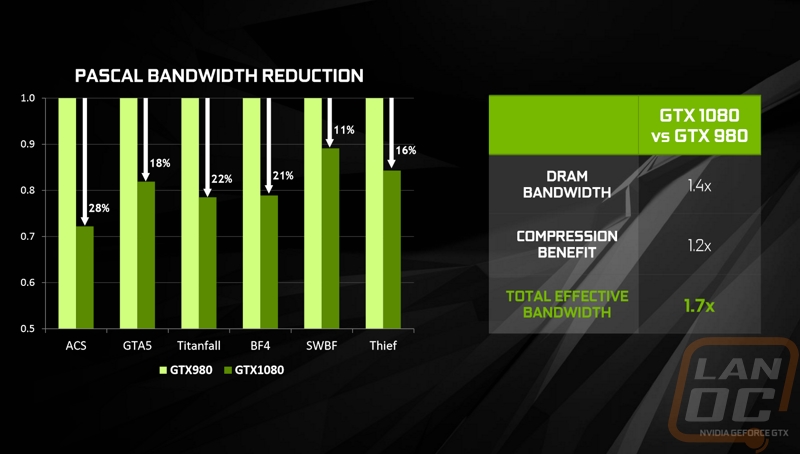
| GTX 1080 | GTX 980 Ti | GTX 980 | GTX 780 | |
| CUDA Cores | 2560 | 2816 | 2048 | 2304 |
| Texture Units | 160 | 176 | 128 | 192 |
| ROPs | 64 | 96 | 64 | 48 |
| Core Clock | 1607MHz | 1000MHz | 1126MHz | 863MHz |
| Boost Clock | 1733MHz | 1075MHz | 1216MHz | 900Mhz |
| TFLOPs | 9 TFLOPs | 6 TFLOPs | 5 TFLOPs | 4.1 TFLOPs |
| Memory Clock | 10Gbps | 7Gbps | 7Gbps | 6Gbps |
| Memory Type | GDDR5X | GDDR5 | GDDR5 | GDDR5 |
| Memory Bus Width | 256-bit | 384-bit | 256-bit | 384-bit |
| VRAM | 8GB | 6GB | 4GB | 3GB |
| TDP | 180W | 250W | 165W | 250W |
| GPU | GP104 | GM200 | GM204 | GK110 |
| Transistor Count | 7.2B | 8B | 5.2B | 7.1B |
| Manufacturing Process | 16nm | 28nm | 28nm | 28nm |
| Launch Price |
MSRP: $599 Founders $699 |
$649 | $549 | $649 |
So when we get down to it how does the GTX 1080 compare to the previous cards like the GTX 980 Ti, GTX 980, and even the older GTX 780. Well, typically when we see a new card you will find the biggest difference in the number of CUDA cores. More cores means more processing power. But the GTX 1080 does something interesting. See the GTX 980 TI actually has more CUDA cores with its 2816 vs the GTX 1080’s 2560 cores. That’s not to say that the GTX 1080 isn’t faster, but they are obviously getting the power from other areas like the memory improvements I already mentioned. Another big reason is that huge difference in clock speeds. We went from seeing low 1GHz clock speeds up to 1607MHz for the core clock and 1733MHz for the boost clock, hell that’s almost double the clock speed of the older GTX 780. We have more memory but the GTX 1080 is sporting a 256-bit controller just like the GTX 980 where the 980 Ti and the GTX 780 have a larger bus width. The TDP is back down as well, just like the GTX 980. What all of this tells me is that just like the GTX 980, Nvidia has left room at the top to respond to anything AMD brings out. Given the huge gains, the GTX 1080 has with its low power usage and low CUDA core the GP100 based Pascal cards are going to be insane!
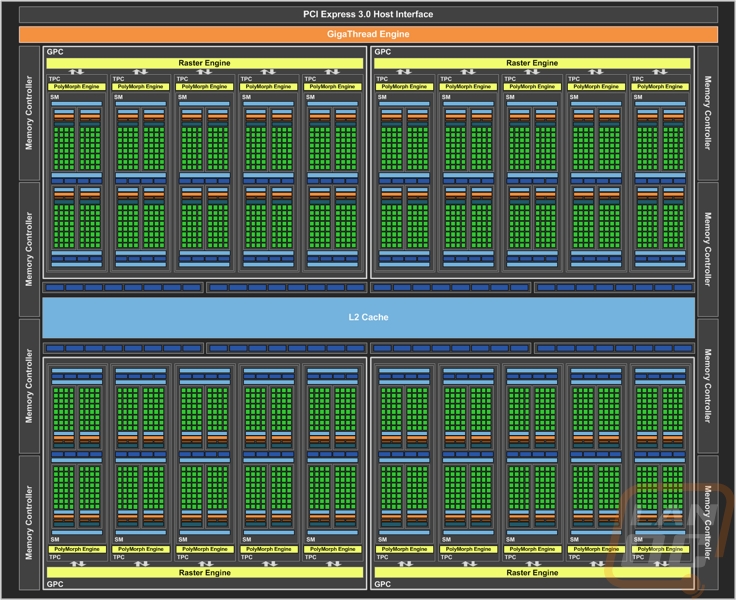
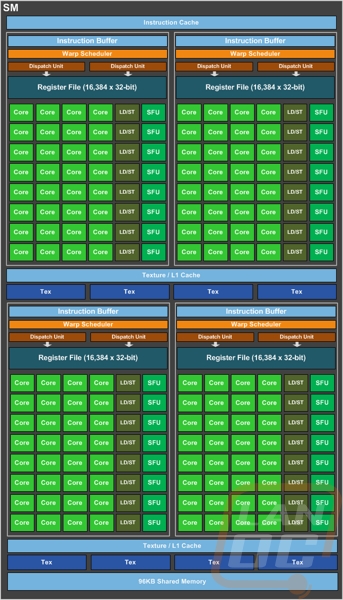
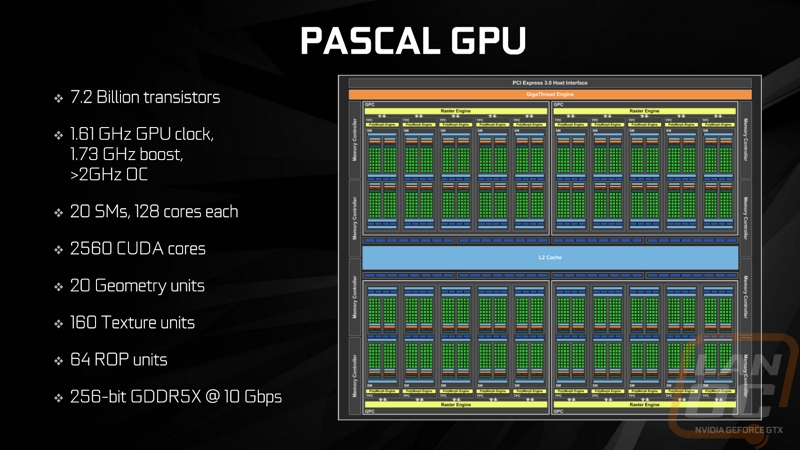
Nvidia also introduced new SLI bridges. In fact, they are calling them SLI HB bridges for their High Bandwidth. These new bridges use both ports and increase the bandwidth between cards. This isn’t a big deal in 1080 or 1400 but when you move up to 4k,5k, and when running surround you need the bandwidth. This does also go along with the announcement that the GTX 1080 only supports SLI with one other card, so 3 and 4 card configurations are out the window now.
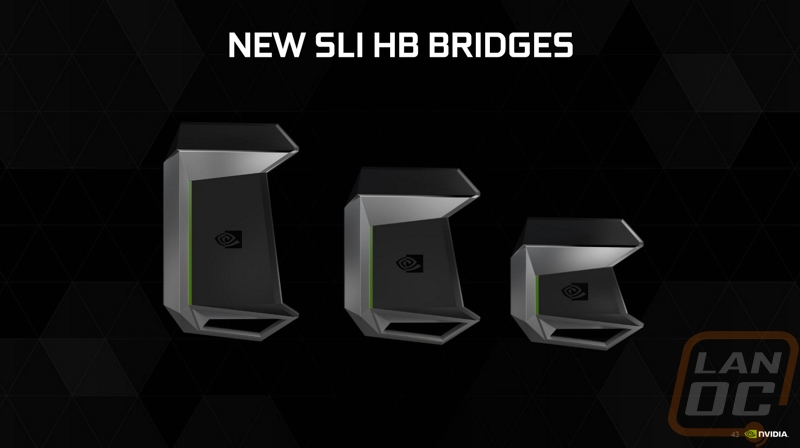
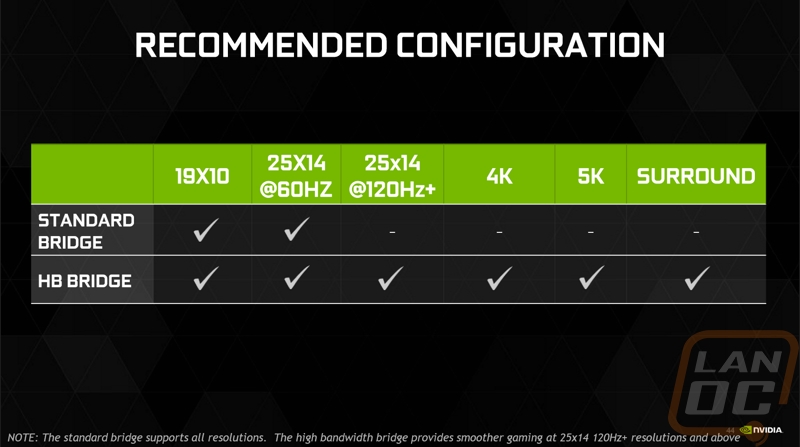
Packaging
For the most part, most people picking up a Founders Edition of the GTX 1080 are going to be buying them from some of the different companies that work with Nvidia. Because of that, the packaging on my card really isn’t going to be like what you would see from them. Nvidia has been selling a few on their website as well though and frankly the packaging is cool enough that I didn’t want it to go unseen. Basically, the card comes in a two part box that opens up by sliding the top portion up and off. It is blacked out with green trim just like you would expect from Nvidia and the front has the fan shrouds angular shape across it. There isn’t anything on the back but they do have the GTX 1080 branding on the front and wrapping around to the side, just like you find on any card.


Inside the card is wrapped up in its static protective bag and it sits in a cutout shape in the foam. They also slipping in the motto “Inspired by gamers, Built by Nvidia” on the green area that was covered up by the top of the box before.

Card Layout and Photos
The last time Nvidia truly changed their reference cooler design was back with the introduction of the GTX 780. They did add some black touches all the way to the blacked out Titan X. For the GTX 1080 though they did change things up a little. The overall design is similar. It has the same layout, metal design, and the window that gives you a look inside of the cooler. But this time around the outside shroud has an angular design. When I first saw leaked images I wasn’t really sure of it. Now that I have it in hand I can say I like it more but I do still prefer the older simpler design, but that is about par for the course as I like simple and clean designs with just about everything.


Even with the new shroud design it doesn’t look like much changed inside of the cooler. The fan design, for example, is exactly the same. It is designed to pull air in from the side of the card, and then push it at a right angle out across the heatsinks to the left and right of the fan. It has the aluminum cap on the center to match the metal fan shroud and the design does highlight the fan with black all the way around it as well as a machined lip around the edge as well. The GTX 180 logo is down on the end and rather than painting it black like the GTX 980 Ti they put chromed letters inside. The acrylic window does help us see that the heatsinks are still blacked out. The window has a little of the angular shape to match the rest of the cooler. The design also has two small windows above and below the window that look similar to break vents on a supercar.




Like all reference designs, the Founders Edition’s fan shroud covers the entire top and bottom edges to keep the air inside blowing at least mostly out of the rear of your case. Cards with aftermarket coolers are able to cool a lot better because they just let air go out wherever they want. That isn’t a big deal with cases that have great cooling, but in tighter builds you can’t afford to have that heat being added into the case. That said the design does have a small vent on the end of the card that faces inside of your case. This is a second heatsink that sits to the right of the fan. It is much smaller, but it helps add to the cooling efficiency of the cooler at the expense of a little heat venting into your case. On the top edge of the GTX 1080, Nvidia did keep the Geforce GTX logo. It is still backlit and it still glows bright green. I was really hoping that this would be the generation that they added RGB lighting to this logo, we know a lot of the aftermarket cards are already doing it. I love having it on the card, but I know a lot of people, myself included, would be a lot more likely to keep them lit if they could match the glowing logo to the color theme of their case.



Around on the back of the GTX 1080 they did keep the sharp backplate from the GTX 980. They dropped the small removable panel and replaced it with a removable panel that is more than half of the backplate. This opens up more airflow when it's needed. The backplate doesn’t have any venting on It but they did put in groves for styling as well as the Nvidia logo and the full GeForce GTX 1080 logo as well.

Up under the all metal fan shroud and backplate we Nvidia is hiding a blacked out PCB as well. The layout is similar to past designs with the GPU over to the left and VRAM chips for the GTX 1080’s 8 gigs of memory positioned around the Pascal chip. Down at the right edge, we can also see that the PCB is designed to have an 8 pin power cable facing out the end where the current layout faces out of the top. I can’t tell if this is in addition to the current power configuration or if it is just designed to have either option. The cooler itself with the shroud off shows us just how much room the heatsink over the GPU and memory takes up. Around the fan, there is a lip that helps blow the air directly over the heatsink as well. The smaller heatsink down at the end almost looks cut off from the airflow and it doesn’t have a vapor chamber or anything attached keeping the design simple.
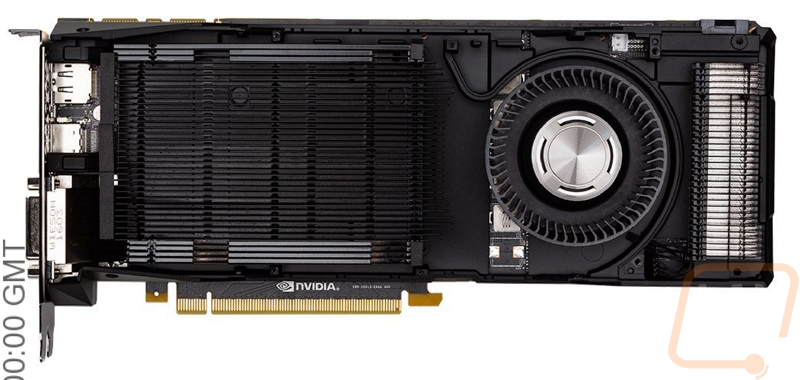
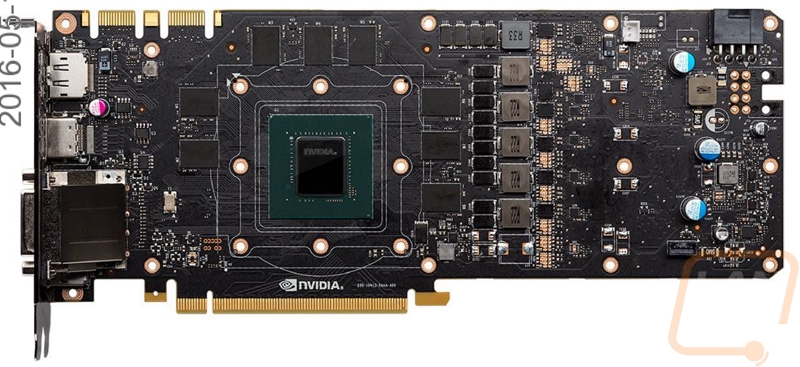
For display connections, the GTX 1080 sticks with the same setup that most new cards have. You get one DVI connection up on the top row. Then the bottom row has three full sized Display Port connections with a single HDMI in there as well. The endplate has triangle shaped vent holes covering just about any open space to help the cooler push as much air out the back of the case as possible.

For power, the GTX 1080 Founders Edition requires just a single 8-pin power connection up on the top edge. This is a big of a change compared to past cards. The GTX 980, for example, had two 6-pins for its reference design and it had a 165 Watt TDP. The GTX 1080 has a higher TDP at 180 Watts and it just uses the single port. This does still leave room for aftermarket cards to add another connector for a little extra overclocking power, though.

So the GTX 1080 does still have two SLI bridge connections up on top even though Nvidia has officially announced that it only supports dual SLI. They have decided to use the dual ports to up the bandwidth when using their new High Bandwidth bridges by using both connections together. The new bridges look amazing and add a run at 650MHz compared to the old 400MHz of the old bridges. They also mention that some older bridges, specifically the ones with built in lighting should also support the new high bandwidth mode as well.

For comparison purposes, I did bring out the GTX 980Ti to compare how the new cooler looks compared to the old design. They are the same length and same width. The backlit logo up looks a lot more packed in with the new design. Beyond that, I covered all of the other differences earlier on.


Our Test Rig and Procedures
| Our Test Rig | ||
| CPU | Intel i7-5960X | Live Pricing |
| Memory | Kingston HyperX FURY Black 32GB Quad Channel Kit 2666 MHz | Live Pricing |
| Motherboard | Gigabyte X99-SOC Champion | Live Pricing |
| Cooling | Noctua NH-U12S Cooler | Live Pricing |
| Power Supply | Cooler Master V1000 Power Supply | Live Pricing |
| Storage | Kingston Hyper X Savage 960GB SSD | Live Pricing |
| Case | Dimastech Test Bench | Live Pricing |
| Our Testing Procedures | |
| 3DMark | The same goes for the most current version of 3DMark using the Fire Strike benchmark in normal, extreme, and ultra settings |
| Unigine Valley Benchmark 1.0 | Using the Extreme HD preset to get an average FPS |
| Catzilla 4k | Default tests for 1080p, 1440p, and 4k resolutions using the overall score for each as our result |
| SteamVR | Default SteamVR test using Average Quality score |
| Ashes of the Singularity | Built-in benchmark ran at 1080p and 1440p with graphics settings set to the “Crazy” setting with the exception of turning off V-Sync Mode. The benchmark scenario is set to GPU Focused and we use the Average Framerate for All Batches as the result |
| The Division | Built-in benchmark ran at 1080p and 1440p with graphics settings set to the default “Ultra” setting with the exception of turning off V-Sync Mode |
| Bioshock Infinite | Using the Adrenaline Action Benchmark Tool we run Bioshock Infinite on the “Xtreme” quality setting. This has a resolution of 1920x1080, FXAA turned on, Ultra Texture detail, 16x Aniso Texture Filtering, Ultra Dynamic Shadows, Normal Postprocessing, Light Shafts on, Ambient Occlusion set to ultra, and the Level of Detail set to Ultra as well. We also run this same test at 2560x1440 using the same settings as mentioned above. |
| Tomb Raider | Using the Adrenaline Action Benchmark Tool we run Tomb Raider on the “Xtreme” quality setting. This has a resolution of 1920x1080, Exclusive Fullscreen turned on, Anti-Aliasing set to 2xSSAA, Texture Quality set to Ultra, Texture Aniso set to 16x Aniso, Hair Quality set to TressFX, Shadow set to Normal, Shadow Resolution on High, Ultra SSAO, Ultra Depth of Field, High Reflection quality, Ultra LOD scale, Post-Processing On, High Precision RT turned on, and Tessellation is also turned on. We also run this same test at 2560x1440 using the same settings as mentioned above. |
| Hitman: Absolution | Using the Adrenaline Action Benchmark Tool we run Hitman: Absolution on the “Xtreme” quality setting other than the MSAA setting is turned down from 8x to 2x. That setting puts the resolution at 1920x1080, MSAA is set to 2x, Texture Quality is set to High, Texture Aniso is set to 16x, Shadows are on Ultra, SSA is set to high, Global Illumination is turned on, Reflections are set to High, FXAA is on, Level of Detail is set to Ultra, Depth of Field is high, Tessellation is turned on, and Bloom is set to normal. We also run this same test at 2560x1440 using the same settings as mentioned above, except on the “high” setting. |
| Sleeping Dogs | Using the Adrenaline Action Benchmark Tool we run Sleeping Dogs on the “Xtreme” quality setting. That means our resolution is set to 1920x1080, Anti-Aliasing is set to Extreme, Texture Quality is set to High-Res, Shadow Quality is High, Shadow Filter is set to high, SSAO is set to High, Motion Blur Level is set to High, and World Density is set to Extreme. We also run this same test at 2560x1440 using the same settings as mentioned above. |
| F1 2014 | We use the built-in benchmark for F1 2014. We use the Ultra setting and then test at 2560x1440 and 1920x1080 |
| Total War: ROME II | Ultra setting tested at 1920x1080 and 2560x1440, built in forest benchmark |
| Middle-earth: Shadow of Mordor | Using the built-in benchmark we test with ultra settings at 1440p |
| Sniper Elite 3 | Ultra setting tested at 1920x1080 and 2560x1440, built in benchmark |
| GRID Autosport | Ultra setting tested at 1920x1080 and 2560x1440, built in benchmark |
| Theif | Tested using the “Very High” setting at 1920x1080 and 2560x1440 |
| Folding @ Home | Using the Folding @ Home benchmark we test both single and double precision using the explicit result |
| Unigine Valley Benchmark 1.0 heat testing | We run through Unigine Valley using the “Extreme” preset for 30 minutes to test in game cooling performance with the fan speed set to auto then again with the fan set to 100%. |
| Power Usage | Using Unreal Valley Benchmark 1.0, we get our “load” power usage number from the peak power usage during our test. We get our numbers from a Kill-A-Watt connected to the test benches power cord. |
| Noise Testing | Our Noise testing is done using a decibel meter 3 inches away from the video card on the bottom/fan side of the card. We test an idle noise level and then to get an idea of how loud the card will get if it warms all the way up we also turn the fan speed up to 50% and 100% and test both speeds as well. The 100% test isn’t a representation of typical in-game noise levels, but it will show you how loud a card can be if you run it at its highest setting or if it gets very hot. |
Synthetic Benchmarks
To start off my testing I like to take a look at a variety of synthetic benchmarks. While they don’t give a great idea of what you can expect for performance in game, they do offer us consistent tests to compare the GTX 1080 to other cards. In addition to the tests I’ve always included, with both Nvidia and AMD introducing new cards I took the chance to update the tests we run and added two new programs and four new tests, doubling the number of synthetic benchmarks we use. In addition, I should also point out that just as I started testing the GTX 1080, our old video card test bench died. Upgrading the dated bench was already being planned, but I had to throw together a new test bench and with that some of our results won’t be consistent. By retesting our GTX 980 Ti and GTX 780 results I was able to confirm that our Synthetic benchmarks are consistent though and don’t require a graph reset like our in-game tests. This is because in 3DMark we have always used the GPU score, not the overall score that takes into account CPU performance at all.
So our first tests were with 3DMark. I ran the GTX 1080 in all three Fire Strike benchmarks to get a good idea of performance at 1080p (performance), 1440p(extreme), and 4k(ultra). Across all three the GTX 1080 outperformed every other single card that we have tested. In fact, it wasn’t even close, especially in the performance setting. The single GTX 1080 did perform very close to the two GTX 980’s in SLI as well.

Next, I ran Unigine’s Valley Benchmark, this is the same test that I use for our power and heat testing because it is a little longer running and we are able to put it on loop as well. This is run at 1080p and once again the GTX 1080 stomped everything else we have tested with the exception of the GTX 980’s in SLI. The Titan X and GTX 980 Ti are nearly 15 FPS slower and those cards are worlds above everything else as well.

Our next test was completely new. I added Catzilla because it has consistent tests at all three resolutions just like 3DMark and frankly because my wife loves the monster cat in the benchmark that is destroying the city. I will be filling in new results later as I get to retesting, but I was able to at least get the GTX 1080 tested along with the GTX 980 Ti and the aged GTX 780. Across all three the GTX 1080 dominated, just like on our previous tests.

Our last benchmark is a simple one, but a sign of things to come. I added the SteamVR test to start off our Virtual Reality testing. In the future, we will be adding more tests as they are introduced, but for now people have been using the SteamVR test as a way to find out if you can expect your video card to handle the ultra-demanding VR. The GTX 1080 received the tests top score of 11 where the GTX 980 Ti was still in the green but did not cap out the test. If you are running the older GTX 780 though, you better not be expecting to jump into VR just yet.

In-Game Benchmarks
So synthetic benchmarks are well and good, but as I’ve always said at the end of the day it’s all about the in-game performance. That’s why we build badass computers right? So the majority of my testing of the GTX 1080 was testing in game performance. I also added two new games to our benchmark suite as well to make sure we are covering the latest and most demanding games. With that, all of the games tested are run at their highest settings with the exception of turning off things like V-Sync that could change the results.
With 11 different games being testing it can get a little crazy to read, so I do like to condense all of our testing down into two graphs to break down the overall playability. This breaks the results down into below 30 FPS that I consider to be unplayable, over 30 FPS but less than 60 that is playable but not ideal, and then everything over 60 FPS is perfectly playable. I do this for both 1080p and 1440p resolutions. As you can see below, the GTX 1080 stomped both of these resolutions. There was only one game that came in below 60 FPS at all and that was Ashes of the Singularity. Even so that was only slightly below 60.


Like I mentioned before, we always have a lot of graphs when you are testing 11 different games. But this time around it is twice as bad because of the last minute demise of our video card test bench. In addition to the newly ran tests on the GTX 1080, GTX 980 Ti, and the GTX 780, I also included our old graphs on the old test bench. We can use the GTX 980 Ti and GTX 780 results for each of those to get a good idea of the performance difference delta between the two but the results still can’t be compared directly.
That said let’s take a look at the game results to see if there is anything interesting. The first interesting result is of course from Ashes of the Singularity, the only game that came in below 60 FPS for the GTX 1080. What was interesting to me was that even though this didn’t hit the over 60 FPS goal on either resolution, the GTX 1080 still performed better than everything else I tossed at it. It looks like I found the new go to test at lower resolutions now that cards can blast through the games that would cause even the best cards to slow down a year ago. The GTX 1080 dominated the charts, putting up numbers faster than even the GTX 980’s in SLI in most tests and not even being close to the next fastest cards like the Titan X in just about every game. Even crazier is that most of the games tested won’t even run into slowdowns on higher refresh rate monitors with games like Sniper even putting down just over 270 FPS. These aren’t basic games and I don’t have the settings turned down, but the 1080 ran through them like I did.




















Compute Benchmarks
Our Compute benchmark section actually got a little smaller with the relook at all of our tests. Our Cinebench results were showing inconsistent results so it was removed. That said I did run the GTX 1080 through both Folding @ Home benchmarks. In the single precision results, the GTX 1080 dominated like expected. For the double precision tests, we once again ran into the issue of Nvidia cutting back their double precision results to leave that for their Quadro cards. Because of this, the GTX 1080 came in well below the higher end AMD cards. It did however finally catch back up to the older GTX 780 that didn’t have the double precision results gimped.


Cooling, Noise, and Power
Beyond the normal performance aspects, another important thing to look at when looking at new video cards are things like the cooling performance, noise performance, and power usage. A card might perform amazing, but if your PSU or case can’t handle it none of it matters. Like in our previous testing, with the sudden change to a new test bench we have broken up our new results into new graphs and included the older results as well for comparison. This was especially important in the power usage testing that I ran first. We can see with the GTX 980 Ti and GTX 780 results that our new test bench, while being faster, pulls a lot less wattage. So the 337 that the 980 Ti pulls on the new test bench turned into 473 on the old bench. That said the 180-watt TDP of the GTX 1080 really helped it keep the wattage low with an impressive 283 watts under load in game for the entire test bench. This is drastically different than both the GTX 980 Ti and the GTX 780 that both had a TDP of 250.


Our next tests were to test the overall noise output of the GTX 1080. While these results didn’t change, I’m taking our test bench issue as a chance to reset these results for the future as well just to keep our graph smaller and easier to read. The old graph was getting a little large and hard to take in. That said the GTX 1080 with the fan turned all the way up only put out 72.4 decibels but I will say the reference design sounds louder than that to the ear. This wasn’t an issue at all during out testing though because it runs very quiet even at 100% load. I wasn’t able to get the card to crank up to 100% fan speed without manually doing it.


For our last batch of testing, I wanted to see just how warm the GTX 1080 runs. When letting the card handle the fan speed it jumped right up to 80 degrees and stayed consistent with a few bumps up to 81 degrees. This is because Nvidia uses a temperature target, letting the card warm up to it before they start to increase fan speed. This helps keep the card extremely quiet, but it does push it a lot closer to thermal issues. In fact, there have been some documented cases of this target temperature lowering the boost clock speeds of the GTX 1080 from time to time. I did a little testing of my own, running a few benchmarks at 100% fan speed as well as with the fan profile set to normal and comparing the results. In those tests, I did normally see the 100% fan speed tests slightly ahead, but it was only normally by .1 of an FPS. I will personally take the lower noise if that is the price.
The second half of my temperature testing was testing the GTX 1080 in Unigine Valley, just like the first test, with the fan set to 100%. This test gives us a better look at the overall cooling potential of the Founders Edition cooler as well as the heat output of the GTX 1080. Well the GTX 1080, even with its lower TDP did run a little warmer than the GTX 980. I think 62 degrees isn’t too bad though, showing that if we adjust the fan profile of the GTX 1080 we could have it running closer to 70 while still being mostly quiet.



Overall and Final Verdict
So this isn’t big breaking news to most of you, but now that we have finally tested the GTX 1080 Founders Edition I can finally say without a doubt that it is a beast. Typically, when we see next generation cards being introduced, they are a gradual improvement over the previous generation. Nvidia dropped the number of CUDA cores but cranked up the clock speeds to a blistering fast 1607/1733MHz and it paid off in our testing. What really impressed me though was the low power usage, our new test bench combined with the GTX 1080 pulled less wattage than our old test bench and the GTX 950 (36 watts to be exact). A lot of that was the test bench, but the GTX 1080 did run 50 watts less than the GTX 980 Ti that it stomped in just about every test. I was a little disappointed that the GTX 1080 only supports dual SLI, though I do think it’s going to rare to find situations where you can really take advantage of more than two cards anyhow. A single GTX 1080 is a 4k or ultra wide resolution card at its core.
So should you run out and pick up a GTX 1080? Yes and No. For starters, you are only going to really be able to take advantage of the card if you are running a higher resolution or a multi-monitor setup. So if you are planning on picking up the GTX 1080 to play your games at 1080p you could save yourself money and still see great performance. The other thing you need to take into account is what you are going to end up paying for the card. Currently, supply low and the pricing has been a little messed up. The Founders Edition that I’m covering here today should be priced $699 and the MSRP for the aftermarket cards $599. There were obviously people upset that Nvidia is charging more for what is basically a reference card. I will say though that while aftermarket coolers can cool better, the Founders Edition does have a full metal design that has to cost more to make than a plastic fan shroud. I also think that given the performance the GTX 1080 is worth the $699, it destroyed the Titan X that was selling for $999 earlier this year.



Live Pricing: HERE




